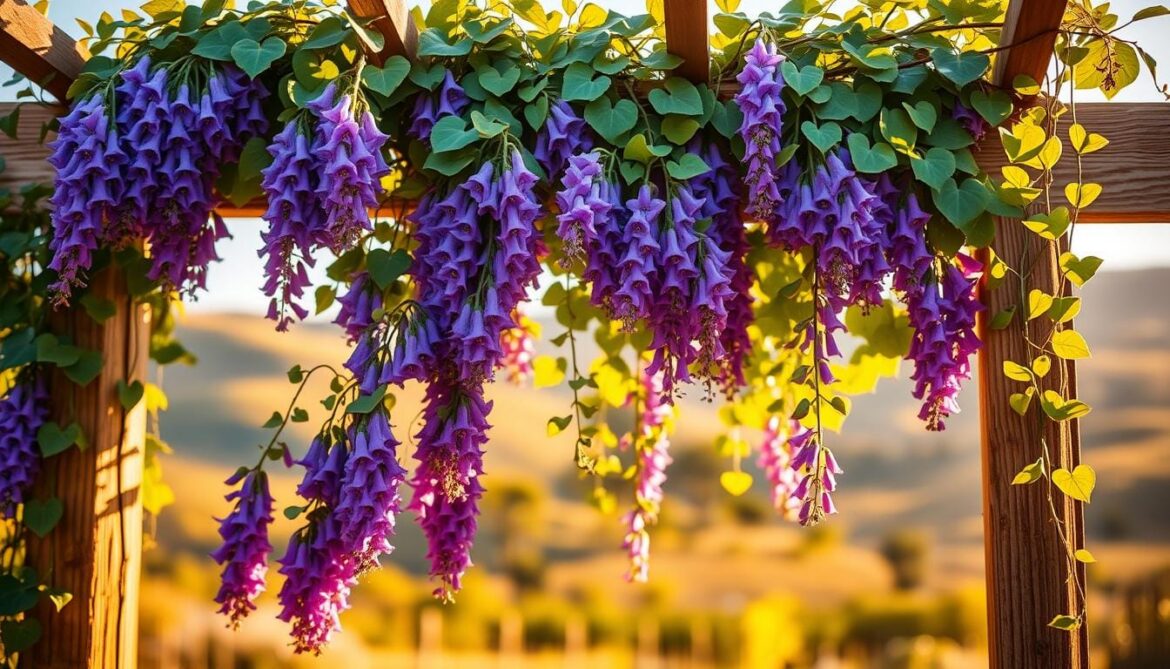Imagine a garden where colors burst with life, and every season brings something new. The hyacinth bean vine could be the star of your backyard. Its striking purple flowers and ornamental seed pods aren’t just eye-catching—they transform spaces into living art. Whether you’re a seasoned gardener or just starting out, growing hyacinth bean vine offers a rewarding journey from planting to harvest. This article guides you through every step to help you cultivate this vibrant climber.
With heart-shaped leaves and showy blooms, this plant thrives in sunny spots, adding vertical interest without demanding constant care. Discover how its lush foliage and dramatic displays can turn an ordinary fence or trellis into a garden highlight. Let’s explore why the hyacinth bean vine is more than a plant—it’s a statement of beauty and resilience.
Key Takeaways
- Hyacinth bean vines produce striking purple blooms and decorative seed pods.
- Easy to grow in sunny gardens, thriving with minimal maintenance.
- Attracts pollinators, enriching garden biodiversity.
- Versatile for trellises, fences, or arbors, adding vertical interest.
- Edible beans and ornamental value make it a dual-purpose plant.
What is a Hyacinth Bean Vine?
The hyacinth bean vine (Lablab purpureus) is a colorful climbing plant from tropical Africa. It’s loved for its beauty and how well it adapts. It grows as a perennial in zones 10-11 and as an annual in other areas. Varieties like L. purpureus ‘Purpureus’ come in different colors and foliage.
Overview of the Plant
This plant is part of the legume family and helps the soil by fixing nitrogen. It uses tendrils to climb and grows clusters of pea-like pods. It’s great for gardens and cooking, and grows fast.
Unique Characteristics
- Purple stems stand out against heart-shaped green leaves.
- Purple flowers bloom from summer to fall, followed by purple seed pods.
- It does well in sun or partial shade and various soils.
Historical Significance
This plant has been grown for over 4,000 years, helping ancient communities in Africa and Asia. Thomas Jefferson even grew it at Monticello in the 1700s. Its beans are eaten worldwide, and its vines symbolize strength in gardening.
Why Choose Hyacinth Bean Vines?
Hyacinth bean vines are more than pretty—they’re practical. They add beauty with little effort, fitting any space.
“Hyacinth bean vines thrive in diverse settings, enriching gardens with color and structure without needing perfection.”
Aesthetic Appeal
Picture purple-tinged leaves, lavender-pink flowers, and striking seed pods. The hyacinth bean vine turns fences, arbors, or garden layouts into stunning displays. Its colors change with the seasons, keeping your garden interesting all year.
Fast Growth Rate
These vines grow fast, reaching 10–20 feet in a season. They’re great for quick privacy or to beautify vertical gardens, all while keeping their charm.
Versatility in Gardening
Hyacinth bean vines fit almost any garden. For small areas, they do well in containers with the right care. Here’s how to succeed with containers:
- Choose a 12–18” pot with holes for drainage
- Install a strong trellis or stake
- Keep the soil moist and fertilize every month
They complement sun-loving plants and can be replanted each year for ongoing growth.
Ideal Growing Conditions for Hyacinth Beans
Learning to grow a hyacinth bean vine begins with understanding its needs. The right soil, light, and climate are key for lush growth and colorful flowers. By getting these basics right, you can enjoy success in your garden.
Soil Requirements
Hyacinth beans love well-draining, rich soil. If your soil is heavy or soggy, add compost or perlite. Aim for a pH of 6.0 to 7.0 for healthy roots. For less fertile soils, mix in organic matter to improve it.
Sunlight Needs
They do best in full sun. Care for hyacinth bean vine means at least 6 hours of direct sunlight each day. In hot areas, morning sun and midday shade help prevent scorching while keeping them strong.
Climate Considerations
These plants thrive in USDA zones 10–11, where they grow year-round. In cooler zones:
- Grow them as annuals in zones 3–9 after the frost is gone.
- In zones 8–10, mulch in winter to keep them alive longer.
- Wait until the soil warms up to 65°F (18°C) for seeds to germinate.
In dry areas, water and mulch well to keep the soil moist.
How to Plant Hyacinth Bean Vines
Learning the basics of planting hyacinth bean vine is key for strong growth and vibrant colors. Follow these steps for a great start.
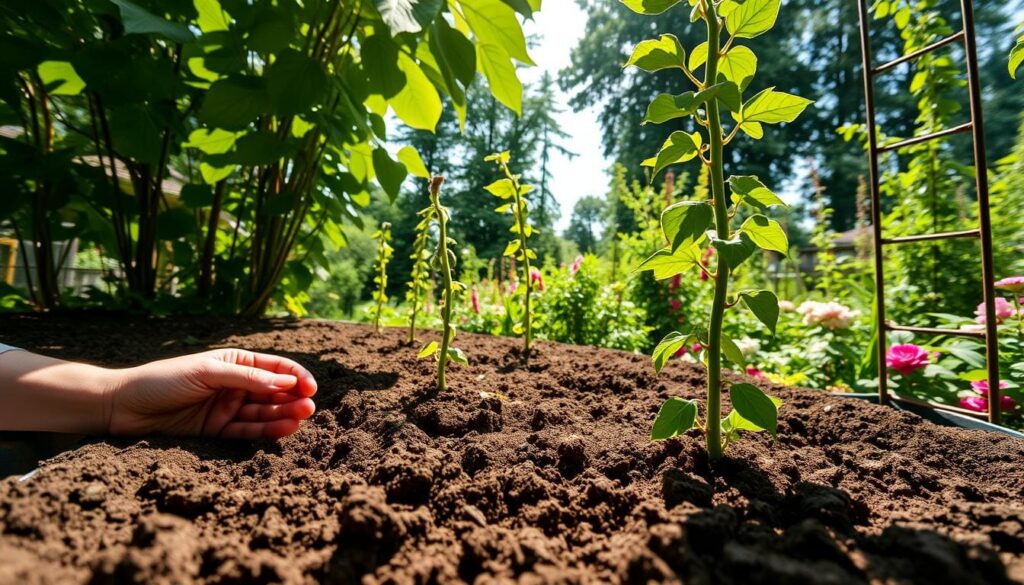
Seed Preparation
Start with hyacinth bean vine seeds. To speed up germination, nick the seed coat with a knife or soak them in lukewarm water overnight. Begin seeds indoors 4–6 weeks before your last frost date in peat pots. Or, sow directly outdoors when soil hits 60°F (15°C).
Planting Techniques
- Plant seeds 1 inch deep, spaced 6–8 inches apart in loose, well-drained soil.
- Water thoroughly after planting but avoid waterlogging.
- Mulch lightly to retain moisture and suppress weeds.
Spacing Guidelines
For healthy growth, space plants 6–8 inches apart on trellises or supports. Keep 3 feet between rows in garden beds. This spacing prevents overcrowding and boosts air circulation.
Timing is important—plant hyacinth bean vine seeds after frost danger passes. In USDA zones 7–11, spring planting is best. Adjust for your local climate for the best results.
Care and Maintenance
For a care for hyacinth bean vine to thrive, it needs regular care. These vines grow well with little help but need occasional checks. This ensures they grow strong and bloom well. Here’s how to keep your growing hyacinth bean vine happy all season.
Watering Practices
- Water deeply once weekly, providing 1–2 inches of water during dry spells.
- Reduce frequency once roots establish but never let soil dry completely.
- Mulch around the base to retain moisture and suppress weeds.
Nutrient Requirements
Hyacinth bean vines don’t need much food but enjoy it now and then. Use a balanced 10-10-10 fertilizer at planting and again mid-season. They fix nitrogen, so don’t overdo it to avoid leggy growth. A soil test kit can tell you if more nutrients are needed.
Pruning Tips
Keep them bushy by pinching back terminal shoots when they’re 12 inches tall. Cut out dead or tangled stems every month for better air flow. Prune hard in late fall to clean up before winter.
Pest and Disease Management
Keeping your hyacinth bean vine healthy means taking care of it early. Look for problems and use natural fixes to keep your vines safe. This way, you avoid using harsh chemicals.
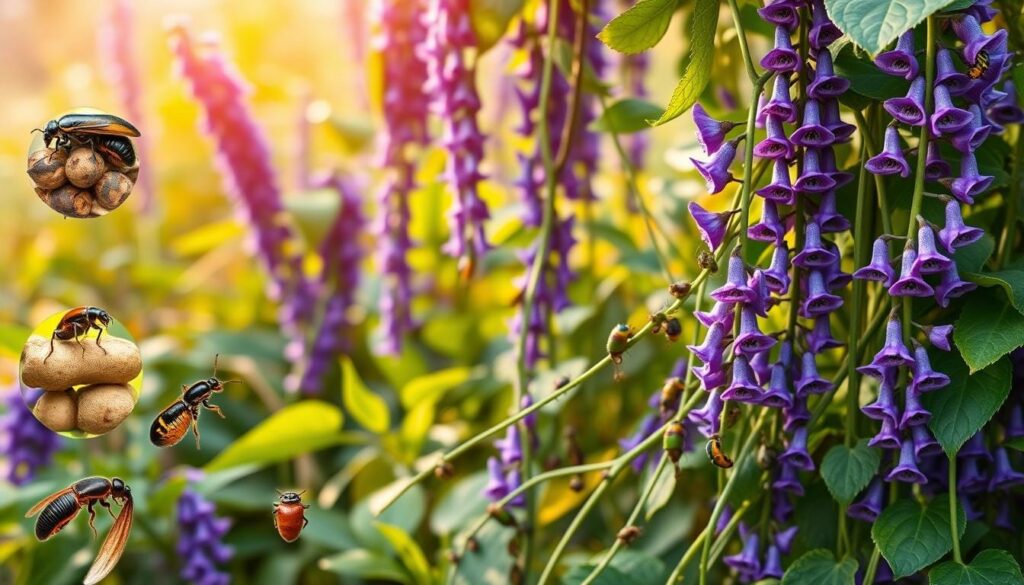
Common Pests
Be on the lookout for these pests that harm hyacinth bean vine:
- Aphids: They form clusters on stems or leaves, making leaves curl.
- Spider mites: You’ll see tiny webs and yellow spots on leaves.
- Bean beetles: They leave holes in leaves and are shiny black.
- Caterpillars: They eat the edges of leaves, leaving them looking like skeletons.
Disease Prevention
To stop diseases, do these:
- Plant them 2–3 feet apart to improve air flow.
- Don’t water from above to avoid too much moisture.
- Take out any fallen leaves to stop fungal spores.
Organic Control Methods
Use these green solutions:
- Neem oil sprays fight aphids and mites.
- Insecticidal soap works on soft-bodied pests.
- Ladybugs are natural aphid eaters.
- Baking soda and water mix can stop mildew.
Acting fast stops pests and keeps your hyacinth bean vine healthy. You won’t need to use harmful chemicals.
Harvesting Hyacinth Bean Vines
Knowing when and how to collect parts of the hyacinth bean vine is key. It lets you enjoy its beauty and taste. Taking good care of the vine is the first step to a successful harvest.
When to Harvest
Timing is everything for using the plant. Pick young pods when they’re 3–4 inches long. This is before the seeds get hard.
Mature seeds are ready when the pods turn brown and brittle. Flowers are best picked when they’re fully bloomed. This is for cooking or making bouquets. Like garlic, patience is important—check this guide for timing tips.
Harvesting Techniques
- Cut young pods with clean shears, leaving stems intact to encourage new growth.
- Clip mature pods close to the stem when dry; store seeds in a cool, dry place.
- Snip flowers early morning for best freshness and fragrance.
Culinary Uses of Beans
Use parts of the hyacinth bean vine wisely:
| Plant Part | Use | Safety Note |
|---|---|---|
| Young Pods | Stir-fries, soups | Wash thoroughly before cooking. |
| Mature Seeds | Soups, roasted snacks | Boil seeds 30+ minutes to neutralize toxins. |
| Flowers | Garnish, teas | Use only freshly picked blooms. |
Always cook mature seeds well. For more on safe harvesting, check out guides like garlic harvesting for tips on other crops.
Propagating Hyacinth Bean Vines
Expand your garden with new hyacinth bean vine seeds or cuttings. Proper propagation ensures healthy plants that thrive year after year. For step-by-step guidance, explore the 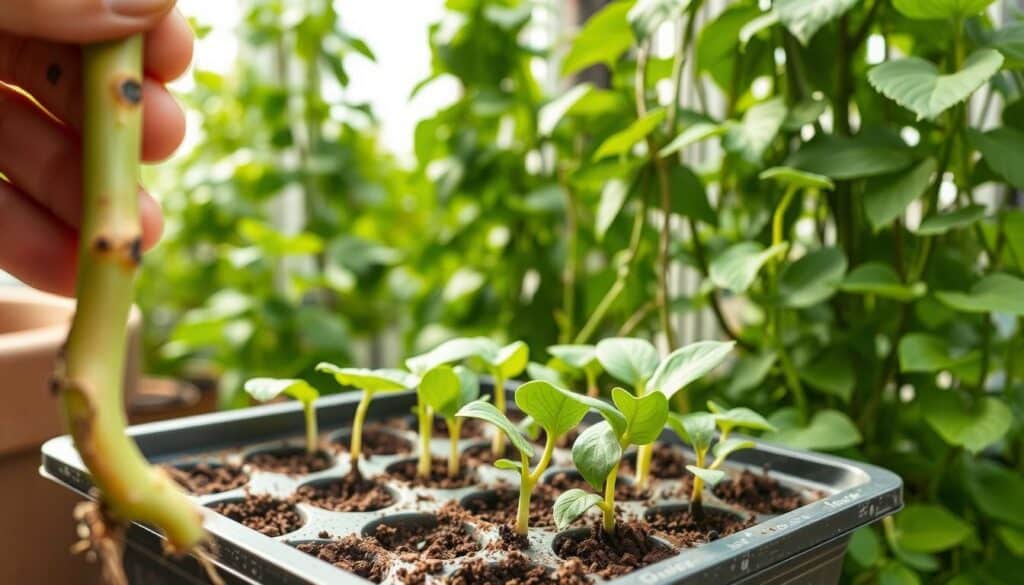
Seed Propagation
Start by harvesting mature pods once they turn brown. Remove seeds, let them dry completely, then store in an airtight container. Plant seeds ½ inch deep in well-draining soil after the last frost. Soaked seeds sprout faster in warm soil.
Cuttings and Division
- Cut 4-6 inch stem sections with nodes, remove lower leaves, and plant in moist potting mix.
- Root cuttings in 6 weeks with rooting hormone for faster results.
- Divide overgrown root clumps in spring, replanting divisions with healthy roots and shoots.
Best Time for Propagation
In USDA zones 8-11, spring or early summer offers ideal warmth for growing hyacinth bean vine. Cooler climates should wait until temperatures stabilize above 60°F. Fall propagation works in frost-free areas. Adjust timing to match local climate patterns.
Companion Plants for Hyacinth Bean Vines
Pairing hyacinth bean vine with the right companions boosts garden health and beauty. These vines thrive when surrounded by plants that share similar needs. Let’s explore top choices for floral and edible neighbors.
Flowering plants like sunflowers and zinnias make vibrant partners. Their sturdy stems provide support while attracting pollinators. Try these combinations:
- Sunflowers: Their tall stalks act as natural trellises
- Zinnias: Bright blooms deter pests with their strong scent
- Salvias: Purple spikes contrast beautifully with the vine’s foliage
Vegetables such as cucumbers and squash benefit from the hyacinth bean vine’s nitrogen-fixing roots. Consider these pairings:
- Cucumbers: Vines climb upward while veggies grow below
- Squash: Large leaves shade the soil, reducing weeds
- Corn: Beans grow up stalks while improving soil fertility
Hyacinth bean vine in containers gains even more benefits when paired strategically. Use these combos for small spaces:
- Window boxes: Combine with trailing petunias for vertical interest
- Patio planters: Add herbs like basil for fragrance and pest control
- Vertical gardens: Mix with annual vines like morning glory for layered growth
Companion planting maximizes space while reducing maintenance. These combinations enhance pollination, natural pest control, and nutrient sharing. For container setups, select compact partners to maintain balance. Experiment with these pairings to create thriving ecosystems in any garden size.
Landscape Design Ideas
Transform simple areas into stunning displays with hyacinth bean vine trellis systems. These vines bring vibrant colors and shape to gardens. Discover unique ways to showcase their purple flowers and heart-shaped leaves.
Vertical Gardens
Make the most of small areas with vertical gardens. Attach hyacinth bean vine to lattice panels or hanging baskets. Here are some ideas:
- Install wall-mounted planters for a living green wall.
- Train vines up freestanding obelisks for a striking centerpiece.
- Use tiered planters to guide growth upward without traditional hyacinth bean vine trellis structures.
Trellising Options
Strong supports are essential for these vigorous vines. Choose from:
- Weather-resistant wooden arches or pergolas.
- Metal frames painted in matching colors.
- Repurposed items like old gates or driftwood for a rustic look.
Make sure bases are sturdy to hold the plant’s weight as it grows.
Creating Focal Points
Stand out with these designs:
- Frame garden entrances with an arched hyacinth bean vine trellis full of foliage.
- Build privacy screens by lining fence lines with dense clusters.
- Pair with annuals like marigolds for layered seasonal color.
Match vertical displays with pathways to guide visitors through the garden’s highlights.
Troubleshooting Common Issues
Even with proper care for hyacinth bean vine, challenges can arise. Here’s how to resolve three frequent problems to keep your vines thriving during growing hyacinth bean vine.
Yellowing Leaves
- Causes: Overwatering, nutrient deficiency, or pest infestations
- Solutions: Let soil dry between waterings. Apply balanced fertilizer. Inspect undersides of leaves for aphids or mites and treat with insecticidal soap.
Wiltinged Plants
- Causes: Root rot from soggy soil or heat stress
- Solutions: Reduce watering frequency. Mulch roots to retain moisture. Avoid overhead watering during hot afternoons.
Slow Growth Problems
- Causes: Cold soil, shaded areas, or compacted soil
- Solutions: Wait until soil warms to 60°F+ before planting. Move to full sun. Loosen soil and add compost.
| Issue | Quick Fix |
|---|---|
| Yellow leaves | Test soil pH and adjust to 6.0–7.0 |
| Wilting | Drill drainage holes in pots or amend heavy soil |
| Stunted growth | Fertilize with nitrogen-rich compost weekly |
Seasonal Care Tips
Seasonal changes require special care for hyacinth bean vine to keep it thriving all year. It’s important to adjust to temperature changes and growth patterns. 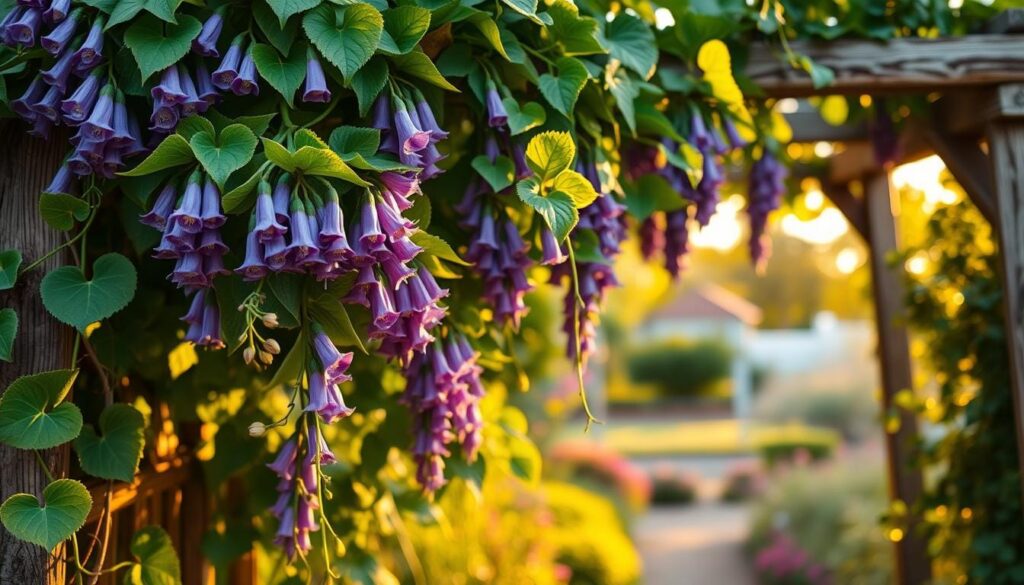
winter preparation
Get your plants ready for cold weather with these steps:
- Collect mature seeds from dried pods before frost sets in.
- Prune dead growth in USDA zones below 8, removing vines at the base.
- Apply 2–3 inches of mulch around roots in mild climates to shield against freezing.
seasonal pruning techniques
Pruning schedules vary by region:
- Early spring: Trim dead stems to promote new growth.
- Midsummer: Remove leggy branches weekly to direct energy upward.
- Fall: Cut vines to ground level in cold zones after frost.
spring awakening care
Start growth with these actions:
“Spring revival hinges on timing and soil readiness.” – National Garden Bureau
Start soil prep 2–3 weeks before the last frost. Remove winter mulch 1–2 weeks after thaw. Water deeply at planting to wake up the roots. In zones 9–11, prune lightly before new shoots appear to encourage branching.
Benefits of Growing Hyacinth Bean Vines
Adding hyacinth bean vine to your garden is more than just pretty. It brings real benefits to your yard and the environment.
Environmental Impact
Hyacinth bean vines stop soil erosion on slopes and bare spots. Their fast-growing roots hold the ground, stopping water from running off. They also pull CO2 out of the air when they’re growing.
Attracting Pollinators
The purple and white flowers attract honeybees and monarch butterflies. A University of Florida study says these flowers are among the best for nectar in late summer. Hummingbirds also visit, making the vine a hub for wildlife.
Enhancing Soil Health
As a legume, the hyacinth bean vine makes the soil better by fixing nitrogen. Its roots have bacteria that turn air nitrogen into a form plants can use. This makes your garden soil richer, cutting down on the need for chemical fertilizers.
“Legumes like hyacinth bean are nature’s soil engineers,” says Dr. Linda Chalker-Scott, Extension Horticulturist at Washington State University.
By adding growing hyacinth bean vine to your garden, you help the environment. You also get to enjoy its beautiful leaves and flowers.
Popular Hyacinth Bean Varieties
Gardeners have a wide range of hyacinth bean vine varieties to choose from. Each variety has its own unique features like flower color, foliage, and growth habits. This makes it easy to find the perfect match for any garden or culinary project.

Purple Hyacinth Bean
The classic hyacinth bean vine is known for its deep purple leaves and violet blooms. The ‘Ruby Moon’ variety is special with its heart-shaped leaves and lavender flowers. It thrives in full sun and adds a bold touch to trellises or pergolas.
White Hyacinth Bean
For a softer look, white-flowered varieties like ‘Alba’ are perfect. They have pale pink blossoms and green pods. These varieties blend well with pastel gardens or moonlight landscapes, adding a gentle touch without overwhelming other plants.
Unique Varieties to Consider
Less common options like ‘Moonshadow’ have silver-splashed leaves that shimmer in sunlight. Ornamental types like ‘Ornamental’ Lablab purpureus have twisted seed pods great for dried arrangements. Edible-focused varieties like ‘Hodgsoni’ offer tender beans for soups and stir-fries.
| Variety | Flower Color | Leaf Features | Best Use |
|---|---|---|---|
| Purple Hyacinth | Violet | Purple-tinged | Showy focal points |
| White Hyacinth | Pale pink | Green | Soft color schemes |
| Moonshadow | Lavender | Silver variegation | Decorative accents |
Seed suppliers like SeedsNow and RareSeeds.com offer these cultivars. Make sure to choose varieties that fit your local climate for healthy growth and stunning visuals.
Using Hyacinth Beans in Cooking
The vibrant hyacinth bean vine is more than just a pretty sight. Its seeds and pods can add unique flavors to your meals. Harvested beans are a nutritious addition when cooked right.
Nutritional Benefits
Hyacinth bean vine seeds are full of protein and fiber, just like lentils. They also have iron and magnesium, making them a great choice for your diet. Their mild, nutty taste is perfect for both savory and vegetarian dishes.
Recipe Inspirations
Discover global recipes that feature hyacinth beans:
| Dish | Region | Preparation |
|---|---|---|
| Stir-Fried Pods | Southeast Asia | Sauté with chili and lime |
| Bean Curry | India | Cook in coconut milk with spices |
| Stewed Beans | Africa | Simmer with tomatoes and herbs |
Safety Precautions
Always cook mature hyacinth bean vine seeds thoroughly to remove toxins. Soak dried seeds overnight and boil for at least 30 minutes. Never eat raw seeds. For safe harvesting, check out this fennel seed guide for handling tips.
Conclusion: Embrace the Beauty of Hyacinth Bean Vines
Hyacinth bean vines are more than just plants. They open the door to colorful gardens and eco-friendly living. Their climbing, blooming, and thriving nature makes them perfect for any outdoor area. Let’s look at their benefits and encourage you to start growing them.
Summary of Benefits
These vines bring excitement with their purple leaves and flowers. They grow fast to cover arbors or hyacinth bean vine trellis structures. They also attract pollinators, supporting local ecosystems.
Their beans are a tasty treat when picked safely. They can be used for privacy or as a garden highlight. They boost both beauty and biodiversity.
Encouragement to Plant
Start by following the right planting hyacinth bean vine steps. Pick a sunny spot, make the soil rich, and choose a trellis that fits your garden. Plant seeds after the last frost for the best growth.
Chiku’s Garden has great tips to help you. With a little patience and care, these vines will give you beautiful leaves, colors, and a healthy garden.
